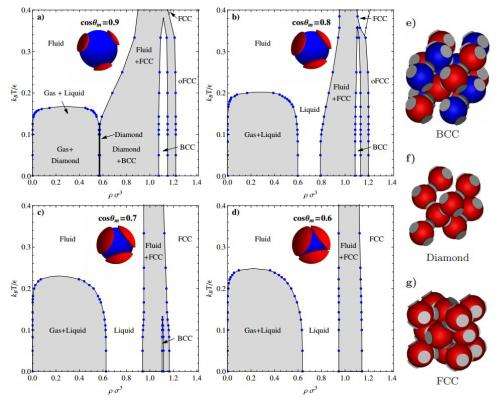August 7, 2013 report
Simulation shows colloids can form into non-crystalline state at below freezing temperatures

(Phys.org) —Two researchers working at Universita di Roma, Frank Smallenburg and Francesco Sciortino have shown via computer simulation that certain colloids can be made to form into a stable non-crystalline state at below freezing temperatures. In their paper published in the journal Nature Physics, the two describe how they used a computer simulation to manipulate virtual flexible bonds representing real colloids and discovered they could be made to hold their liquid-like structure even at very low temperatures.
In the natural world, when liquids are frozen they form into crystals. This is because as heat dissipates a crystalline structure is favored because it's the most energy efficient state. One exception to the rule is glass, which exists as both a liquid and a solid. Now it appears there are other exceptions as well.
In their work studying colloids (liquids with tiny particles suspended in them—milk, wine, etc.) the researchers noted the flexible bonds that existed between the particles—pure liquids such as water typically have few bonds between the molecules in them and as a result are relatively stiff. Colloids also have more of the bonds that tie them together offering more possibilities for joining configurations as heat energy is reduced pulling the molecules closer together. In manipulating the way the bonds formed between the various molecules in their simulation, the two researchers found that they could prevent the liquid from forming as a crystal when the temperature was lowered. The result was a frozen material that was not crystallized, which technically—because its molecules were unordered—makes it a liquid. Remarkably, the frozen colloids were more stable than they would have been had they been allowed to form into crystals. The researchers note it appears the colloids would not crystallize as the temperature was dropped even lower, unless they were highly compressed.
The researchers also ran simulations of real colloids and found it worked with them just as well. Thus, if a way can be found to reproduce the same process in the real world, the result might be new kinds of materials (probably polymers) that could be used for altogether new purposes. The two researchers report that they are already at work with another team in investigating such possibilities.
More information: Liquids more stable than crystals in particles with limited valence and flexible bonds, Nature Physics (2013) doi:10.1038/nphys2693 . www.nature.com/nphys/journal/v … /full/nphys2693.html On ArXiv: arxiv.org/pdf/1307.1842.pdf
Abstract
All liquids (except helium owing to quantum effects) crystallize at low temperatures, forming ordered structures. The competition between disorder, which stabilizes the liquid phase, and energy, which leads to a preference for the crystalline structure, inevitably favours the crystal when the temperature is lowered and entropy becomes progressively less relevant. The liquid state survives at low temperatures only as a glass, an out-of-equilibrium arrested state of matter. This textbook description holds inevitably for atomic and molecular systems, where particle interactions are set by quantum-mechanical laws. The question remains whether it holds for colloidal particles, where interparticle interactions are usually short-ranged and tunable. Here we show that for patchy colloids with limited valence, conditions can be found for which the liquid phase is stable even in the zero-temperature limit. Our results offer fresh cues for understanding the stability of gels and the glass-forming ability of molecular network glasses.
Journal information: Nature Physics
© 2013 Phys.org





















